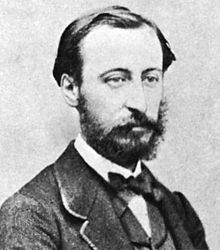3rd piano concerto (Saint-Saëns)
The 3rd Piano Concerto in E flat major , Op. 29 , is a work for piano and orchestra by the French composer Camille Saint-Saëns .
Emergence
The third piano concerto was written in 1869, just one year after completing his second piano concerto . It appears larger in the external layout, both in the duration of the performance and in the scoring, which now also includes trombones, for example. The musical design is a lot more romantic and enthusiastic than in the previous concerts and thus suggests, for example, concerts by Rachmaninoff . This change in style to the previous work is due to the in-depth study of contemporary romantic music in Europe at the time of its creation. The creative process therefore took a lot more time than the previous concert, which took just 17 days. The third piano concerto, on the other hand, was written over a period of about a year.
The work is dedicated to Élie Miriam Delaborde.
To the music
occupation
Solo piano , 2 flutes , 2 oboes , 2 clarinets , 2 bassoons , 2 horns , 3 trombones , 2 trumpets , timpani and strings
1st movement: Moderato assai - Piu mosso
The exposition is introduced by soft arpeggio chords from the piano before the horn introduces the main theme. This receives its final shape in a large-scale symphonic intensification of piano and orchestra. Hectic figures of the piano and orchestra take up the horn motif again and calm the scene. A second, somewhat indistinctly articulated thought by the piano is expanded on calm orchestral chords with interesting chromatics . The piano now develops this idea solo into the pronounced second theme of the movement. The musical statement remains elegiac and enthusiastically indistinct, as is often the case with Sergei Rachmaninoff, for example . A new dynamic arises in the implementation . With downward movements, which are developed from the main theme, the orchestra forms the basis for virtuoso and sometimes rhythmically innovatively shifted thoughts of the piano. The recapitulation is followed by a longer piano solo cadenza, which ends with the flute performing the main theme. The full orchestra soon sets in with the main theme, accelerating the action and leading to a virtuoso coda of the long movement.
2nd movement: Andante
The middle movement loosely represents the form of a three-verse song. The movement begins on a quiet organ point of the orchestra, on which the piano makes some threatening sounding interjections. Shortly afterwards, the main lyric theme is heard in the strings and is performed extensively. Only after a while does the piano throw in phrases that still seem threatening. String tremolos answer these objections. Only the return of the lyrical theme in the strings (2nd stanza) causes a final change of mood, as the piano now responds with peaceful and gentle interjections in piano . The cello brings the end of the engaging set a third recurrence of the subject, which again threatening objections of double bass and piano entails and the set attacca can pass into the final movement.
3rd movement: Allegro non troppo
The final movement, which is directly linked to the Andante, develops its joyous main theme through the piano on loud orchestral chords. A second dance thought is added by the cellos to the pounding rhythm of the rest of the orchestra. The lively event is changed and repeated a few times before the concert comes to a short but triumphant conclusion.
effect
The first performance took place in 1869 in the Gewandhaus Leipzig under the direction of the composer himself. This performance was a similar failure as the world premiere of the 2nd Piano Concerto a year earlier in Paris. The German audience was not very enthusiastic about the overly romantic and rambling character of the work. To this day, the concert is less popular than its sister works and is performed less often. A few years later Saint-Saëns arranged the piece for two pianos, as he had done in his 1st piano concerto .
Web links
- Piano Concerto No. 3, Op.29 (Saint-Saëns, Camille) : Sheet music and audio files in the International Music Score Library Project
- Summary of Saint-Saëns' piano concertos ( Memento from May 28, 2014 in the Internet Archive )
